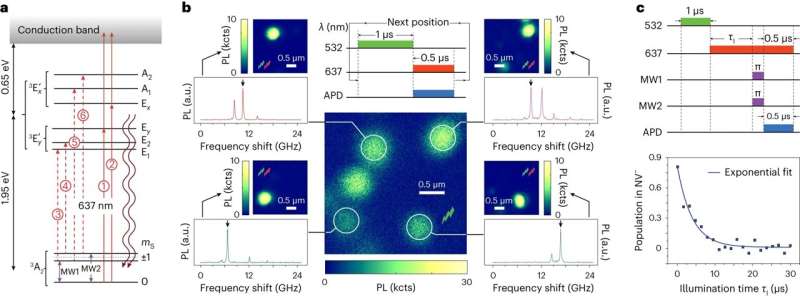This article has been reviewed according to Science X's editorial process and policies. Editors have highlighted the following attributes while ensuring the content's credibility:
fact-checked
peer-reviewed publication
trusted source
proofread
Optical data storage breakthrough increases capacity of diamonds by circumventing the diffraction limit

Physicists at The City College of New York have developed a technique with the potential to enhance optical data storage capacity in diamonds. This is possible by multiplexing the storage in the spectral domain. The research by Richard G. Monge and Tom Delord, members of the Meriles Group in CCNY's Division of Science, is titled "Reversible optical data storage below the diffraction limit" and appears in the journal Nature Nanotechnology.
"It means that we can store many different images at the same place in the diamond by using a laser of a slightly different color to store different information into different atoms in the same microscopic spots," said Delord, a postdoctoral research associate at CCNY. "If this method can be applied to other materials or at room temperature, it could find its way to computing applications requiring high-capacity storage."
The CCNY research focused on a tiny element in diamonds and similar materials, known as "color centers." These, basically, are atomic defects that can absorb light and serve as a platform for what are termed quantum technologies.
"What we did was control the electrical charge of these color centers very precisely using a narrow-band laser and cryogenic conditions," explained Delord. "This new approach allowed us to essentially write and read tiny bits of data at a much finer level than previously possible, down to a single atom."
Optical memory technologies have a resolution defined by what's called the "diffraction limit," that is, the minimum diameter that a beam can be focused to, which approximately scales as half the light beam wavelength (for example, green light would have a diffraction limit of 270 nm).
"So, you cannot use a beam like this to write with a resolution smaller than the diffraction limit because if you displace the beam less than that, you would impact what you already wrote. So normally, optical memories increase storage capacity by making the wavelength shorter (shifting to the blue), which is why we have 'Blu-ray' technology," said Delord.
What differentiates the CCNY optical storage approach from others is that it circumvents the diffraction limit by exploiting the slight color (wavelength) changes existing between color centers separated by less than the diffraction limit.
"By tuning the beam to slightly shifted wavelengths, it can be kept at the same physical location but interact with different color centers to selectively change their charges—that is to write data with sub-diffraction resolution," said Monge, a postdoctoral fellow at CCNY who was involved in the study as a Ph.D. student at the Graduate Center, CUNY.
Another unique aspect of this approach is that it's reversible. "One can write, erase, and rewrite an infinite number of times," Monge noted. "While there are some other optical storage technologies also able to do this, this is not the typical case, especially when it comes to high spatial resolution. A Blu-ray disk is again a good reference example—you can write a movie in it but you cannot erase it and write another one."
More information: Richard Monge et al, Reversible optical data storage below the diffraction limit, Nature Nanotechnology (2023). DOI: 10.1038/s41565-023-01542-9
Journal information: Nature Nanotechnology
Provided by City College of New York





















